Genre: Action Developer: Loriciel Publisher: Piko Int. Players: 1 Released: 2020
Over its lifespan, the Genesis had a lot of games come and go that never got a chance to see the light of day on store shelves. Some like Shadow of the Beast III and Black Crypt were announced but vanished without a trace. Others, like Beyond Zero Tolerance and Time Trax had unfinished prototypes, but no official release. And then there are the few games that were basically done but were held back for one reason or another. It’s in this third category that we find Jim Power: The Lost Dimension, as it was all but done and ready to go under the name Jim Power: The Arcade Game in 1994. But like those other games, it fell away and never surfaced… until now. Piko Interactive got the rights to the game and proceeded to wrap up the loose ends so that it could be released in 2020. The question is, was the game worth the time and money spent getting it out the door? Read on.
The vile supernatural alien named Vaprak is eyeing up our planet in his bid to gain access to a vortex that would enable him to reach the fifth dimension; the “lost” dimension. Our world is the last planet that stands in his way of getting to that vortex, and that’s where agent Jim Power comes in. A full frontal assault isn’t possible, thanks to how powerful Vaprak’s forces are. So Jim Power must go it alone, getting by the Omni-eye scanners so that he can assassinate the alien leader and save our world from impending doom.
There are a number of things about this game that stand out. The first of which, are the graphics. When you’re on foot, you’ll be attacked by armored men, flying beasts, large dogs, exploding barrels, animated spike pits, giant bees, plants, alien creatures, zombies, and, in true European style, the dreaded falling water drops. All of them are colorful, nicely detailed and shaded, and their animations are quite smooth. When you’re in your spaceship, it’s much the same. Colorful and nicely animated enemy ships and creatures come at you, with plenty of detail being put into their other-worldly designs. The bosses you fight at the end of the stages are large and equally colorful and details as they’re moving about the screen. Admittedly, their animations are more minimal given their size, but those little touches (how their eyes open and close, rolling wheels, etc.) are still smooth. This all adds up to the game featuring some nicely done sprite work.
The backgrounds are just as impressive to look at. Loads of color and detail, animated touches like rain, fiery fountains, water streams, and there are a variety of locales such as the shore of a big lake, caves, a fog-laden graveyard that leads into a village, and even a Space Harrier-esque checkerboard. There’s also quite a bit of parallax scrolling going on, with an effect being used that makes it feel as if you’re running and flying in a really big circle. It’s a trippy little touch that can be a bit disorienting to some, but I liked it. However, that parallax does gradually dwindle as the game goes along, going from roughly 10-plus layers on the first stage, to just two on the final one. That said, the backgrounds, like the sprites, are handled well. And, when coupled with the sprites, show that the Genesis color pallet was being put to good use with a solid amount of attention being given everything visually.
When it comes to the sound in this game, it’s pretty solidly done as well. The gun is given different sounds as it gets powered up, the bits of voice featured are what you’d expect from the Genesis (grainy, but understandable), and little things like item pick-up effects, explosions and whatnot all do their job without being problematic or unpleasant. The music, however? That’s where the audio shines. The music compositions by Chris Huelsbeck are exactly what you’d expect from him. Catchy melodies, powerful drums, layered synths, nice sounding instruments… a very Mega Turrican-like vibe to it all. There’s really nothing to complain about in this area, as he delivered a well done soundtrack to listen to as you play. And this all leads to a game that, like the visuals, comes off well aurally.
With the gameplay, it’s a pretty straightforward and basic affair. You’ll find that the game is broken up into three segments. Stages one, four, and seven sees your character running through the stages on foot. You’ll shoot enemies, jump over pits, navigate environmental hazards, and make your way to the end where a boss will be waiting (with stages one and four having you fight while flying via a jetpack). Stages two and five are traditional shmup levels, with you piloting a spaceship and avoiding enemies, their bullets, environmental hazards, and fighting a multi-screen boss at the end. Stages three and six are really just bonus stages to collect coins for points and grab keys as you go along to open up walls so you don’t run into them. There are no boss fights or enemies, but you can still take damage.
Weaponry is minimal, with a gun that can be powered up bit by bit throughout the game, though it does level up a lot by the time you reach the final boss. However, the shooting in this game is a bit different. You can fire while moving about the screen in your spaceship on the shmup levels, but your character stops running to shoot his gun when you’re on foot. You also have a bomb to use that gives you a few moments of invincibility while it damages enemies.
Getting away from the weapons, you can jump while on foot, and use a quick burst of speed to dart forward while in your spaceship. You’ll also find coins that pop up for points to earn extra lives, items that give points/bombs/1-ups, and clocks to give you more time. Yes, this game has a timer for each stage. You always have no more than one minute and fifty nine seconds on the clock, but those clock icons I mentioned always push it back up to one minute and fifty nine seconds when you pick one up. And if you run out of time, you die. This keeps you moving, because you’ll be surprised at how quickly the timer runs out if you try to carefully make your way through the various “on foot” missions.
Each level is filled with the various enemies I mentioned earlier (and more). While you’ll find yourself dealing with them as they come from all sides and try to shoot/ram you, you’ll also come across things that try to crush you, pits and spikes to jump over, and there will even be areas where the stage speeds up on you abruptly. Sure, it’s all stuff that’s been done before in other games, but it still keeps some variety in there to make sure the game doesn’t feel like a dull slog to play through. And lastly, there’s the challenge level selection. “Easy” lets you take two extra hits before you die on the third hit, “Normal” lets you take one extra hit, and “Hard” is the one-hit-kill setting. Couple that with just three continues, and this game can be brutal at first.
So all of that sounds like it might make for a reasonably fun game, right? The question then becomes, “So what’s wrong with the game?” And to be honest, there are a number of things that could have been done better; the first of which is the jumping. Most times, when you press the jump button in a game, your character jumps once, even if you hold down the button. With this game, if you hold down the jump button, your character will constantly jump like they have a pogo stick up their ass. And if you’re not careful, that fact can and will lead to taking damage or being killed because you didn’t let go of the button soon enough when your character lands. But, if you just tap the button, you don’t jump as high/far, so you have to hold it down to make a lot of the jumps in this game. This creates an annoying setup that didn’t need to exist.
Up next, the shmup/coin collection stages. While the “on foot” stages are challenging and done pretty well, the shmup stages falter a bit. With the ship and enemies being as large as they are, it doesn’t leave you with as much room to maneuver as one would like to have with such stages. Things feel cramped, even when the area around you is wide open, because of the size of everything. As for the coin collection stages, they’re just… dull. Yeah, it’s a way to earn points for extra lives, and the key collecting bit to open walls adds a little to them, but they’re uninteresting and feel like something done to pad the game out a bit. And while it’s clear that these were done to replace the overhead stages on the SNES version, they’re a poor substitute.
Then we come to the hit detection. It’s not utterly busted, but there are moments when it seems like the hit boxes get randomly wonky. Objects like the giant spike balls and the fire fountains can hit you when they actually didn’t at times, and I’ve been hit by stationary ground spikes after my character was standing on the edge of a stationary platform for a few seconds. They just suddenly did damage while I wasn’t moving, with no other enemies around. Things like this don’t happen often, but they do happen.
Lastly, we come to the visibility of enemies and such. While the graphics are nice, they also tend to hide some of the things going on. Everything is colorful and has a higher contrast with the shading. This ends up making things blend together too well at times, resulting in enemies and bullets not being as visible as they should be, as well as you not being sure what you will and won’t interact with in the backgrounds.
So what can be said about Jim Power: The Lost Dimension? Well, it stumbles in spots. The visuals, the music, the challenge level… all of that is done well. But it also lacks the depth of other games like it, the hit detection is a bit iffy, the coin stages are boring, and things like the enemy/background visibility issue doesn’t help either. Still, there’s really nothing glaringly broken with the game. It’s not buggy or impossible to beat, but it’s also not a shining example of the genre. Yes, it’s great that the game finally got to see the light of day (unlike that finished Indiana Jones Genesis game that’s now lost for good). But to be honest, it won’t set your world of Genesis gaming on fire. Instead, it’s simply a solid entry into the system’s library; nothing more, nothing less. And if you approach it as such, you’ll likely have fun with it.
SCORE: 7 out of 10

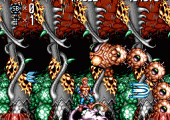
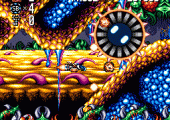
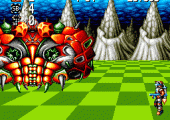
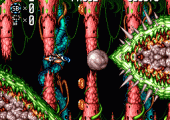
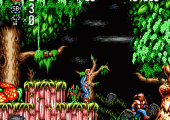
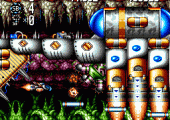
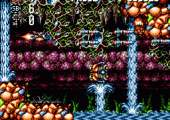
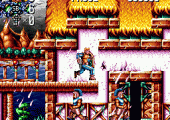
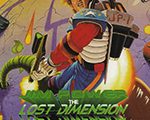
Recent Comments